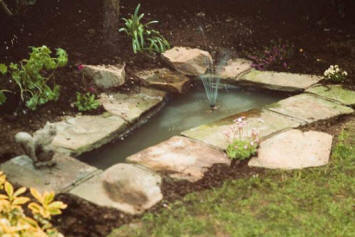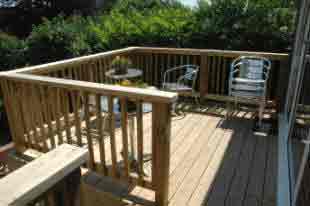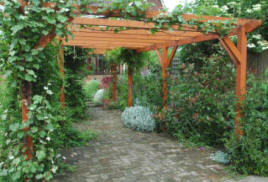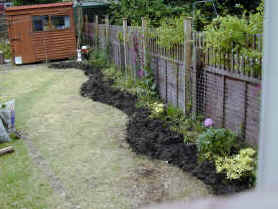
This area and the links will give you landscape gardening tips and much of the advice and help you require for your own landscape gardening project.
Design and build your own landscape garden! There are many aspects to landscape gardening - several different 'skills' are needed to build your own landscaped garden. It does not need to be big, just start with an area which maybe negelacted or overgrown.
Hopefully, these projects will take you through the whole process of landscaping - from designing your own garden to to completed job - not that a garden is ever completed of course!
The main bit of advice must be to 'take your time' in all aspects of Landscape Gardening. Whatever you build or install, has the potential to be with you for the rest of your life. Get your landscape project, designed properly, and do not move forward until you have seen what it looks like on the ground.
I started a project in May 2018, only about 200 sqm, I thought i would be finished in a month, between other jobs, well i will post the before and after photos when i have actually finished, hopefully by July 2019... Projects do take time...

Design Your Own Garden
Not the impossible task it might seem - especially with our helpful guide and tips! Take your time; be innovative; involve everyone; agree basics; be flexible!
We have all seen Ground Force and modernly Love your Garden, all of these start with a plan, it does not have to be a computised auto cad plan, but just sketch something out and even mark up the area and visualise how it would look.

Brickwork in the Garden
How to do brickwork in your own garden. The basis many good landscape features is good brickwork. There was a time when brickwork was an essential part of any landscape gardening scheme. Times and fashions move on. In the case of brickwork, cost has been a factor in its seeming lack of popularity. Good brickwork will add emphasis, and is versatile to be included in most landscape designs.
Laying bricks is a straightforward process for any DIY enthusiast. Bricks can add maturity and a warm effect to many gardens. Learn about brick laying here.
The brick walls of a house have two primary physical functions. One is to hold up a roof, and the other is to form a framework around a set number of rooms (a) for privacy and (b) to stop the wind from getting in. They are also useful for hanging pictures; and of course a doorway would not be a lot of use without a wall.

Building a Garden Deck
Many things need to be taken into consideration when deciding upon a deck. Not least, the changing weather patterns which seem to be altering our general approach to the garden and how to best use it.
All stages of the operation to build your own deck are important. NoE trying to cut corners - other than for the shape of your deck! use only the best materials - specially manufactured for building exterior decks.
If you are unsure, then don't ask a friend - ask a professional! As well as the time and money you could waste with a bodged-up deck, do you really want to go through life having an eyesore in the back garden - or worse still, having an unsuitable deck that no-one wants to use!

Build a Rockery
Rock Gardens are great for creating interest in many parts of the garden. However, your rockery is best suited near to the house or patio - unless you are an avid 'visitor' to your own garden. The reason being, that the plants which make your rock garden a success, are usually small, dainty little alpines, and do not normally create the 'wash' of colour that looks good from a distance!
Together with this, Rockeries need to be kept under observation, for weeds can soon take hold, and if they are allowed to become established in your rockery, are very difficult to remove without damage to your choice plants.
The plants that are normally planted - and grow well - in rockeries, are those which are happy in dry areas.

Building a Pergola
Many good garden centres, and a few online garden stores will have ready made pergola kits available. However if you want a good sturdy framework for plants, hanging baskets, and the like, then you will stand a better chance if you build your own pergola - custom made for your own requirements.
If you are capable of carrying out the work required to erect a ready-made kit, you should be able to build your own pergola with timber from your local timber stockist.
You WILL need basic DIY skills - and also a little help from a friend once you get round to the actual erection of your own timber garden pergola.

Curves in the Garden
There is nothing better than a hosepipe (!) for shaping curved borders and beds in the garden. The better quality ones - that don't kink - are best, but a 'cheapy' filled with water will also do the trick.
The main advantage is that you can actually see your curves before scratching out a line on your prized turf, or slicing into it with a sharp spade. You can leave the hose in place and situate a few shrubs or flowering plants around to get the 3-dimensional feel of what your curve is going to do for you.

Levelling the Garden
Levelling is of particular importance for the construction of patios and lawns. Assess the area to be levelled carefully in order to minimise the amount of soil to be moved during levelling. If a garden has considerable variations in level it may be more realistic to work with the contours, constructing walls, terraces, sunken gardens and or water features. There are many instances where it may be necessary to level your garden.
Choose your level; one which will not entail too much removal or addition of soil, and knock in a master marker peg. Using a level board, (a straight plank approximately 2m long and 2cm thick,) knock in other pegs level with the master peg, by placing the level board on the master peg and the new peg and aligning with a spirit-level on top of the level board.
View your local suppliers of | Paving Supplies | and Topsoil Supplies in our Business Directory